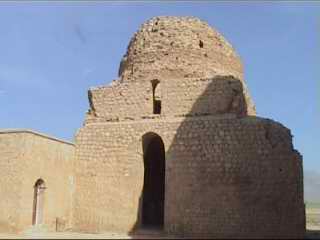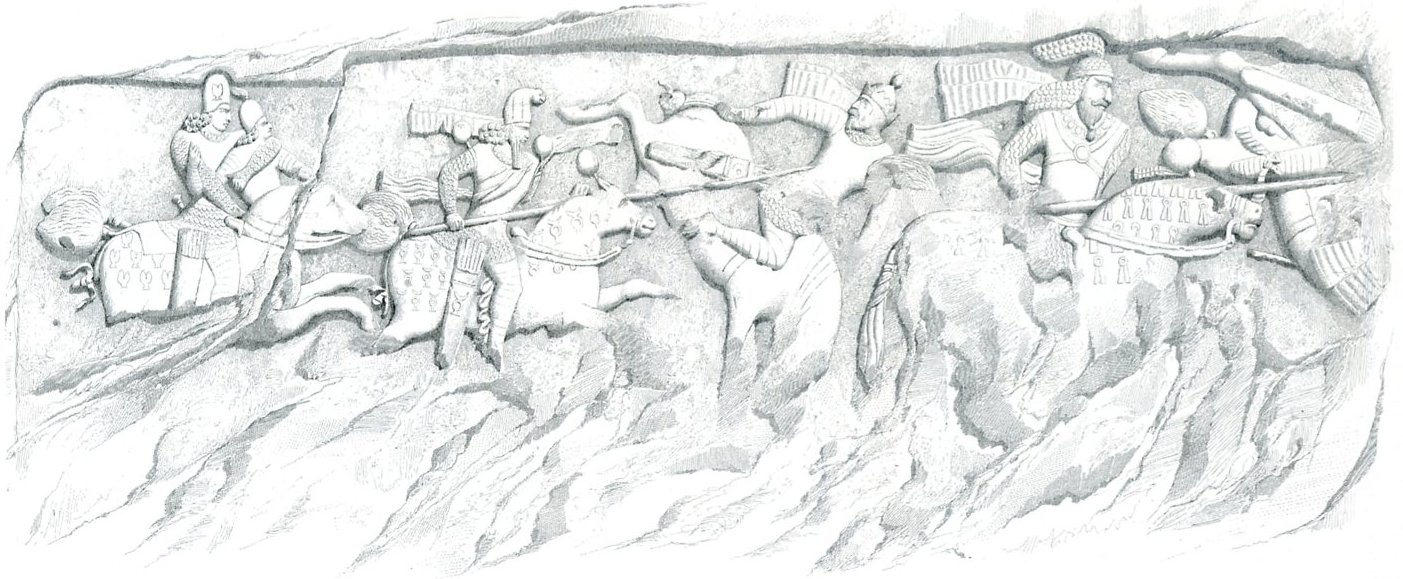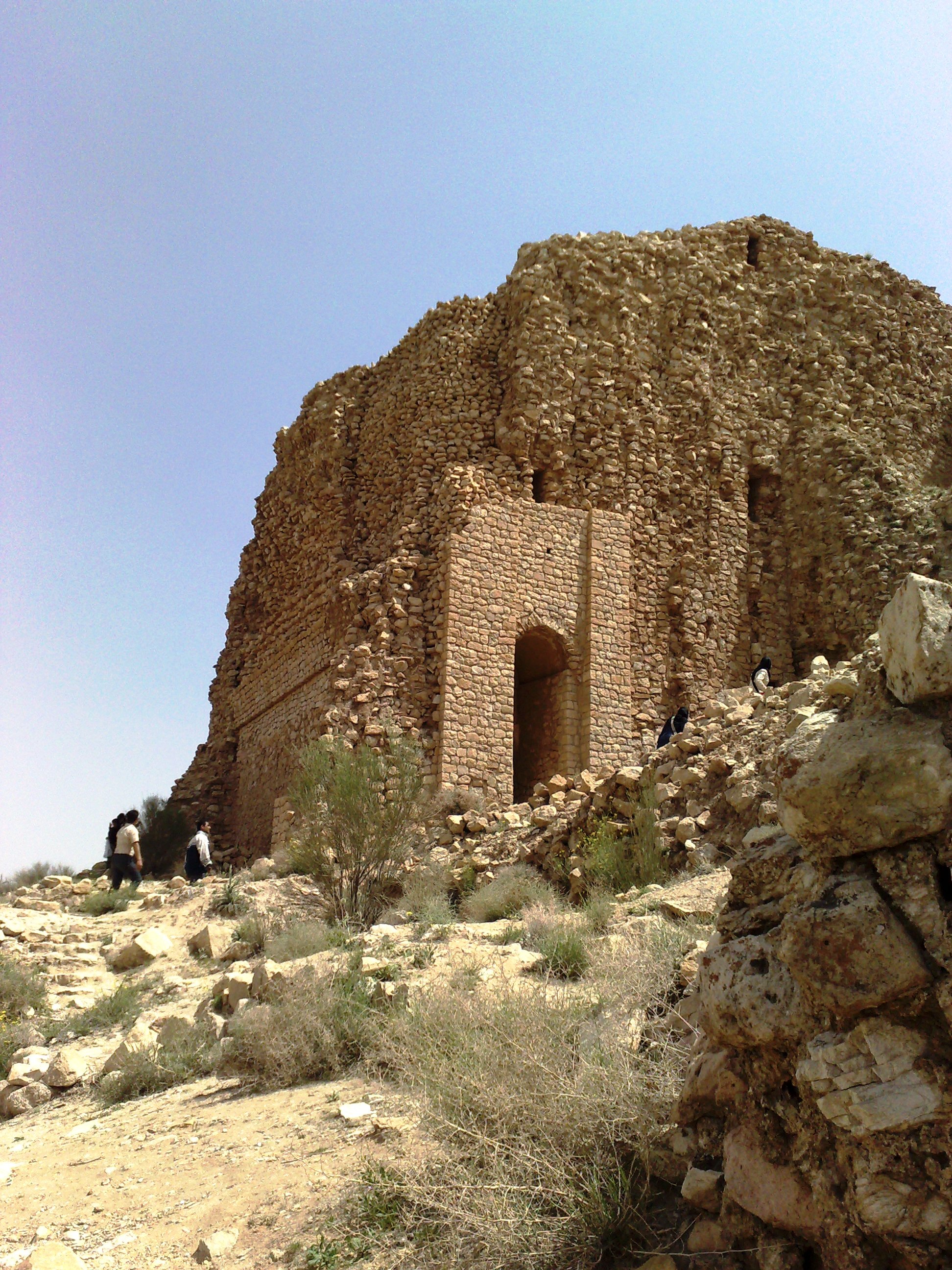|
Sarvestan Palace
The Sassanid Palace of Sarvestan () is a Sassanid-era building in the Iranian city of Sarvestan, some 90 km southeast from the city of Shiraz. The palace was built in the 5th century AD, and was either a gubernatorial residence or a Zoroastrian fire temple. History The Sarvestan Palace was built by the Sasanian king Bahramgur (; r. 420–438) and dominates an immense, empty plain. The name "palace" is considered misleading, because the monument's function is obscure. It may have been a hunting lodge or a sanctuary instead of a palace, because of the presence of a small building, just north of the palace, whose function remains unknown. Palace court A visitor who would have arrived from the south, would have seen three iwans. After entering the central one, he would have reached a large square hall under a large dome, made of baked brick. After this, a visitor would have found himself on a rectangular courtyard, surrounded by the residential quarters. The building remind ... [...More Info...] [...Related Items...] OR: [Wikipedia] [Google] [Baidu] [Amazon] |
Shiraz
Shiraz (; ) is the List of largest cities of Iran, fifth-most-populous city of Iran and the capital of Fars province, which has been historically known as Pars (Sasanian province), Pars () and Persis. As of the 2016 national census, the population of the city was 1,565,572 people, and its built-up area with Sadra, Fars, Sadra was home to almost 1,800,000 inhabitants. A census in 2021 showed an increase in the city's population to 1,995,500 people. Shiraz is located in Southern Iran, southwestern Iran on the () seasonal river. Founded in the early Islamic period, the city has a moderate climate and has been a regional trade center for over a thousand years. The earliest reference to the city, as ''Tiraziš'', is on Elamite clay tablets dated to 2000 BCE. The modern city was founded by the Sasanian dynasty and restored by the Umayyad Caliphate in 693 CE and grew prominent under the successive Iranian peoples, Iranian Saffarid dynasty, Saffarid and Buyid dynasty, Buyid dynastie ... [...More Info...] [...Related Items...] OR: [Wikipedia] [Google] [Baidu] [Amazon] |
Sassanid Archaeological Landscape Of Fars Region
Sassanid Archaeological Landscape of Fars Region () is the official denomination given by UNESCO to eight Sasanian Empire, Sasanian-era archaeological sites situated in the southeast of Fars province, Iran. It was recognized on 30 June 2018 as a UNESCO World Heritage Site. Sites References {{World Heritage Sites in Iran World Heritage Sites in Iran ... [...More Info...] [...Related Items...] OR: [Wikipedia] [Google] [Baidu] [Amazon] |
Ghal'eh Dokhtar
Qal'eh Dokhtar, Ghale Dokhtar, Dokhtar Castle or Dezh Dokhtar (, "The Maiden Castle") is a castle made by Ardashir I, in present-day Fars, Iran, in 209 AD. It is located on a mountain slope near the Firouzabad- Kavar road. Name The name of the castle implies it was dedicated to the Goddess Anahita, to whom the term "Maiden" refers. Location The castle is built on a high bluff which overlooks the river and roadway running south from Fars. Specification It was presumably roofed by an arched vault. Beyond this there are steps to a third level and a large rectangular room with ¼ circle squinches at each corner supporting a domed roof. This was buttressed by very thick walls on all sides, presumably to ensure its stability, and the cupola could be reached by a spiral staircase on the south side. The 1,800-year-old castle has lost some four meters of its original height over the last century and experts warn if urgent measures are not taken to enforce it, the castle may s ... [...More Info...] [...Related Items...] OR: [Wikipedia] [Google] [Baidu] [Amazon] |
Sasanian Palaces
The Sasanian Empire (), officially Eranshahr ( , "Empire of the Iranians"), was an Iranian empire that was founded and ruled by the House of Sasan from 224 to 651. Enduring for over four centuries, the length of the Sasanian dynasty's reign over ancient Iran was second only to the directly preceding Arsacid dynasty of Parthia. Founded by Ardashir I, whose rise coincided with the decline of Arsacid influence in the face of both internal and external strife, the House of Sasan was highly determined to restore the legacy of the Achaemenid Empire by expanding and consolidating the Iranian nation's dominions. Most notably, after defeating Artabanus IV of Parthia during the Battle of Hormozdgan in 224, it began competing far more zealously with the neighbouring Roman Empire than the Arsacids had, thus sparking a new phase of the Roman–Iranian Wars. This effort by Ardashir's dynasty ultimately re-established Iran as a major power of late antiquity.Norman A. Stillman ''The Jews of ... [...More Info...] [...Related Items...] OR: [Wikipedia] [Google] [Baidu] [Amazon] |
Buildings And Structures On The Iran National Heritage List
A building or edifice is an enclosed structure with a roof, walls and windows, usually standing permanently in one place, such as a house or factory. Buildings come in a variety of sizes, shapes, and functions, and have been adapted throughout history for numerous factors, from building materials available, to weather conditions, land prices, ground conditions, specific uses, prestige, and aesthetic reasons. To better understand the concept, see ''Nonbuilding structure'' for contrast. Buildings serve several societal needs – occupancy, primarily as shelter from weather, security, living space, privacy, to store belongings, and to comfortably live and work. A building as a shelter represents a physical separation of the human habitat (a place of comfort and safety) from the ''outside'' (a place that may be harsh and harmful at times). buildings have been objects or canvasses of much artistic expression. In recent years, interest in sustainable planning and building pract ... [...More Info...] [...Related Items...] OR: [Wikipedia] [Google] [Baidu] [Amazon] |
Sasanian Castles
The Sasanian Empire (), officially Eranshahr ( , "Empire of the Iranian peoples, Iranians"), was an List of monarchs of Iran, Iranian empire that was founded and ruled by the House of Sasan from 224 to 651. Enduring for over four centuries, the length of the Sasanian dynasty's reign over ancient Iran was second only to the directly preceding Arsacid dynasty of Parthia. Founded by Ardashir I, whose rise coincided with the decline of Arsacid influence in the face of both internal and external strife, the House of Sasan was highly determined to restore the legacy of the Achaemenid Empire by expanding and consolidating the Iranian nation's dominions. Most notably, after defeating Artabanus IV of Parthia during the Battle of Hormozdgan in 224, it began competing far more zealously with the neighbouring Roman Empire than the Arsacids had, thus sparking a new phase of the Roman–Iranian Wars. This effort by Ardashir's dynasty ultimately re-established Iran as a major power of late an ... [...More Info...] [...Related Items...] OR: [Wikipedia] [Google] [Baidu] [Amazon] |
History Of Persian Domes
Persian domes or Iranian domes have an ancient origin and a history extending to the modern era. The use of domes in ancient Mesopotamia was carried forward through a succession of empires in the Greater Iran region. An ancient tradition of royal audience tents representing the heavens was translated into monumental stone and brick domes due to the invention of the squinch, a reliable method of supporting the circular base of a heavy dome upon the walls of a square chamber. Domes were built as part of royal palaces, castles, caravansaries, and temples, among other structures. With the Muslim conquest of Persia, introduction of Islam in the 7th century, mosque and mausoleum architecture also adopted and developed these forms. Structural innovations included pointed domes, drums, conical roofs, double and triple shells, and the use of muqarnas and bulbous forms. Decorative brick patterning, interlaced ribs, painted plaster, and colorful tiled mosaics were used to decorate the exteri ... [...More Info...] [...Related Items...] OR: [Wikipedia] [Google] [Baidu] [Amazon] |
Iranian Architecture
Iranian architecture or Persian architecture (, ''Me'māri e Irāni'') is the architecture of Iran and parts of the rest of West Asia, the Caucasus and Central Asia. Its history dates back to at least 5,000 BC with characteristic examples distributed over a vast area from Turkey and Iraq to Uzbekistan and Tajikistan. Persian buildings vary greatly in scale and function, from vernacular architecture to monumental complexes. In addition to historic gates, palaces, and mosques, the rapid growth of cities such as the capital Tehran has brought about a wave of demolition and new construction. According to American historian and archaeologist Arthur Upham Pope, Arthur Pope, the supreme Iranian art, in the proper meaning of the word, has always been its architecture. The supremacy of architecture applies to both pre- and post-Islamic periods. Iranian architecture displays great variety, both structural and aesthetic, from a variety of traditions and experience. Without sudden innovatio ... [...More Info...] [...Related Items...] OR: [Wikipedia] [Google] [Baidu] [Amazon] |
Firuzabad, Fars
Firuzabad () is a city in the Central District (Firuzabad County), Central District of Firuzabad County, Fars province, Fars province, Iran, serving as capital of both the county and the district. Firuzabad is south of Shiraz, Iran, Shiraz. The city is surrounded by a mud wall and ditch. The original ancient city of Gor, dating back to the Achaemenid period, was destroyed by Alexander the Great. Centuries later, Ardashir I, the founder of the Sassanid Empire, revived the city before it was ransacked during the Muslim conquest of Persia, Arab Muslim invasion of the seventh century. It was again revived by the Buyids under Fanna Khusraw, but was eventually abandoned in the Qajar Iran, Qajar era and was replaced by a nearby town, which is now Firuzabad. Its only surviving structure is the central core, an ancient Minar (Firuzabad), tower. History Gor dates back to the Achaemenid Empire, Achaemenid era. It was situated in a low-lying area of the region, so, during his invasio ... [...More Info...] [...Related Items...] OR: [Wikipedia] [Google] [Baidu] [Amazon] |
Ardashir I
Ardashir I (), also known as Ardashir the Unifier (180–242 AD), was the founder of the Sasanian Empire, the last empire of ancient Iran. He was also Ardashir V of the Kings of Persis, until he founded the new empire. After defeating the last Parthian Empire, Parthian King of Kings, shahanshah Artabanus IV of Parthia, Artabanus IV on the Battle of Hormozdgan, Hormozdgan plain in 224, he overthrew the Parthian Empire, Arsacid dynasty and established the Sasanian dynasty. Afterwards, Ardashir called himself ''shahanshah'' and began conquering the land that he called ''Iran (word), Eranshahr'', the realm of the Arya (Iran), Iranians. There are various historical reports about Ardashir's lineage and ancestry. According to al-Tabari's ''History of the Prophets and Kings'', Ardashir was son of Papak, son of Sasan. Another narrative recorded in Kar-Namag i Ardashir i Pabagan, ''Kar-Namag i Ardashir i Pabagan'' and Ferdowsi, Ferdowsi's ''Shahnameh'' states that Ardashir was born from the ... [...More Info...] [...Related Items...] OR: [Wikipedia] [Google] [Baidu] [Amazon] |
Iwan
An iwan (, , also as ''ivan'' or ''ivān''/''īvān'', , ) is a rectangular hall or space, usually vaulted, walled on three sides, with one end entirely open. The formal gateway to the iwan is called , a Persian term for a portal projecting from the facade of a building, usually decorated with calligraphy bands, glazed tilework, and geometric designs. Since the definition allows for some interpretation, the overall forms and characteristics can vary greatly in terms of scale, material, or decoration. Iwans are most commonly associated with Islamic architecture; however, the form is pre-Islamic Iranian in origin and was invented much earlier and fully developed in Mesopotamia around the third century CE, during the Parthian period. Etymology ''Iwan'' is a Persian word that was subsequently borrowed into other languages such as Arabic and Turkish. The New Persian form is ''eyvān'' and its etymology is unclear. A theory by scholars like Ernst Herzfeld and Walter Bruno He ... [...More Info...] [...Related Items...] OR: [Wikipedia] [Google] [Baidu] [Amazon] |









